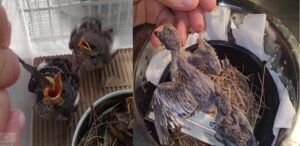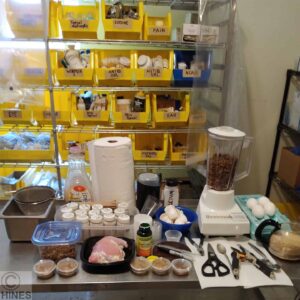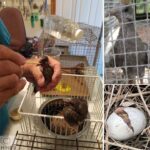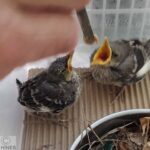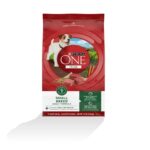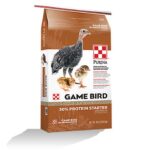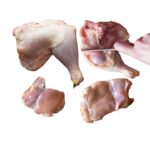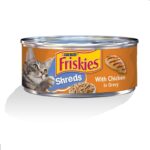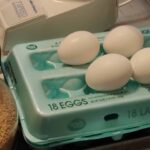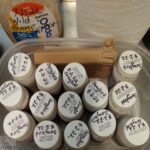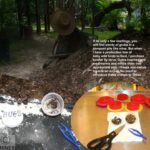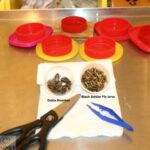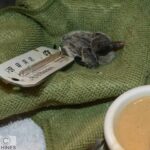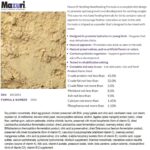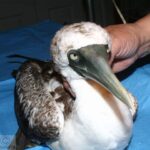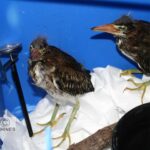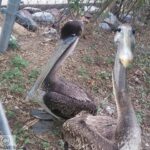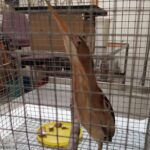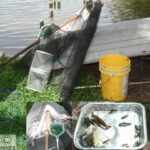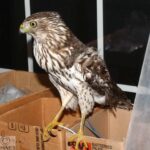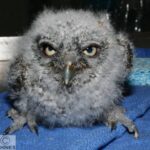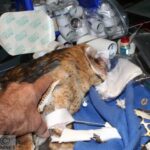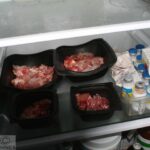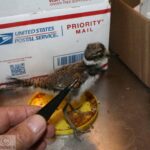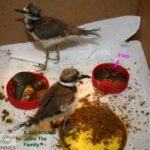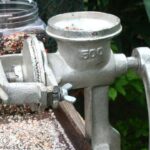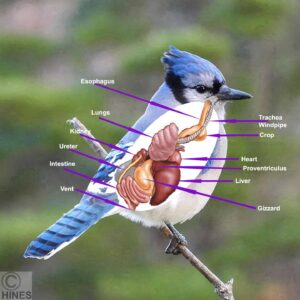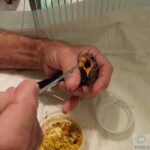 Leg Weakness In Baby Songbirds And How To Avoid It
Leg Weakness In Baby Songbirds And How To Avoid It
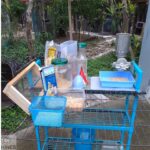 Do Wild Birds Need Grit, What Kind How Much?
Do Wild Birds Need Grit, What Kind How Much?

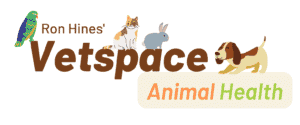
Wild Baby Bird Diets
Ron Hines DVM PhD
Dear Reader, I don’t suppose that there are two wild bird rehabilitators in America feeding identical diets or using the same feeding techniques. So, it’s always good to know what works for others. My techniques you can read below. Send me your diets and techniques and I will post them at the bottom of this page. RSH
Doves And Pigeons
You can read an earlier article specifically on dove and pigeon diets here. My baby whitewing doves this summer are getting a mixture of about 80% Gerber’s instant baby oatmeal, 20% Kaytee Exact small parrot and cockatiel powdered diet, two raw beaten large eggs and about a quarter teaspoon full of powdered eggshells. No mourning or inca doves have come in – probably because we are in a severe drought. I have a Krups electric coffee grinder. It powers the eggshells so fine that it behaves more like smoke than coarse powder.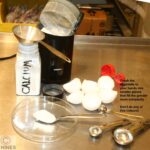
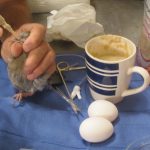
All the ingredients, before and now fit, into a 4 inch-tall coffee cup: First I add the powdered ingredients until it fills a bit over half the cup. Then I add enough water to cover the dry ingredients making the cup about 3/4 full. Then I mix it with a spoon. Then I put it in our microwave for 1 minute. Then, when it has cooled, I add the raw eggs – but not the shells. Then I beat it all with a spoon until the egg whites and yolk are unrecognizable. That is best done in a bowel. After that, I tablespoon it into little disposable condiment cups with snap on lids. I freeze those until I need them. I once bought a thousand clear plastic disposable 3 ml laboratory pipettes. 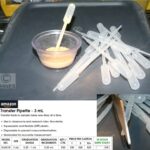
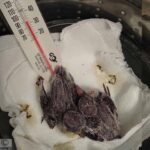
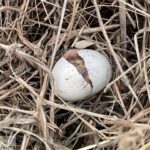
Songbirds
Songbird doesn’t mean that all of these birds all sing a peasant tune. The proper term for these birds is passerine or perching birds. Raptors and owls (stringids) perch too. But they have their own separate designations.
I used a Hamilton Beach blender, set on liquify, to prepare batches of this diet. Then I place small amounts in containers and freeze them. It consisted of approximately 40% pre-soaked Purina One+PLUS small breed Lamb & Rice Formula Dog Food, 30% Purina wild game bird starter, 10% raw, skinned, deboned chicken quarters with the fat removed, 10% whole hard-boiled eggs and 10% Purina Friskies Shreds Chicken in Gravy canned cat food. The Shreds™ seems to make the mixture smoother – probably because it contains corn starch, soy flour and other emulsifiers. A diet like this has worked well for mockingbirds, curved bill thrashers, altamira orioles, kiskadees, green jays, curved bill thrashers, long-tailed grackles, golden fronted woodpeckers and pauraques. It most likely would for many other songbird birds as well. It’s just that the ones I mentioned are the ones that are the most frequently brought to me.
Next year, I intend to add extra B-complex vitamins. To read about weak legs and other diet-related problems that occasionally occur in baby songbirds here.
Insects
I also offer baby birds that naturally eat insects diced mealworms, crickets and wood cockroaches, etc. in addition to the songbird diet. I attempt to wean woodpeckers over to an all-insect diet using the stumps above. Mealworms fit snugly into the pre-drilled holes. So do sections of nightcrawlers that have been frozen and thawed before feeding. Fresh, wild nightcrawlers carry a number of parasites. (read here) Worm farm crawlers are probably OK – if the worm farm supplying them, or you don’t utilize chicken manure or hen house litter. For the same reasons, I never feed pillbugs or sowbugs. They transmit quite a few avian parasites if they fed on bird droppings. You can read about that here. If you are only raising a few orphaned nestlings, you can collect quite a few wood cockroaches and earwigs by laying down 4′ x 8’sections of old carpet, keeping them moist and turning them over now and then for bug harvest. I feed songbirds insects as well because even seed eating songbirds present insects to their young. When our compost pile can’t keep up with my needs, I purchase mealworms, soldier fly larva and dubia roaches online.
Laboratory Spatulas Are Helpful
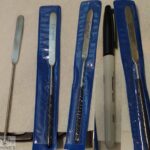
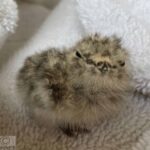
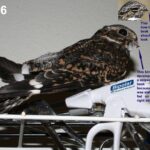
Temperature
Birds maintained at the wrong temperature do not digest their food well. (read here) I maintain container temperature for baby bird environments at about 32 C/89.6 F. The only time I exceed that is when birds come in chilled (hypothermic) as they do in winter. Thirty-two degrees C is considerably lower than the internal (core) temperature of adult songbirds. However, the babies are already generating some of their own internal heat through metabolism. If their mother was sitting on them, her skin temperature is considerably lower than her core body temperature and her breast feathers reduce heat transfer to her babies even more. Based on observation rather than experiments, I believe that nestlings digest and thrive best when their surroundings are kept at about 32 C. To do that I plug air conditioner vents, confined the babies to draft-free “nest” containers and use flexible desk lamps with 100 watt Double Life bulbs. I have heat lamps and herp/reptile lamps; but I find them cumbersome and dangerous. At 38 C, the doves I raise begin to pant and are in obvious discomfort.
I live in the tropics. Most of the infant songbirds that come in are in heat shock. They are dehydrated. I never feed hypothermic or hyperthermic or dehydrated nestlings. I give them subcutaneous injections of 5% dextrose in 0.45% saline donated by my local hospitals using a U-40 syringe. If that is not an option for you, unflavored Pedialyte electrolyte solution, given orally in small drop by drop amounts, is your best option. Never give a second drop until you see that the first one was swallowed.
I have a lot of respect for Mazuri™. Mazuri was once the agricultural division of Ralston Purina Company. But when Nestlé purchased Purina in 2001, their interest was only in Purina’s dog and cat food lines. After all, Nestlé realized that there was no limit to what “pet parents” would pay for their dog or cat’s food. But farmers using Mazuri products knew exactly what their turkeys, chickens, hogs and cattle would sell for at market and weren’t about to pay more for their feed than they would eventually earn from the livestock’s sale. So, When Nestlé acquired Purina, the Purina Mazuri Division was sold off to Land O’Lakes, the butter and dairy cooperative. Land O’Lakes renamed what they bought Purina Mills™. Mazuri’s nestling Hand feeding formula is primarily composed of powdered whole dried egg and chicken meal. Powder whole egg is is about 48% protein and 44% fat. Chicken meal is about 65% protein and 12% fat. However besides vitamins, Mazuri adds rosemary extract, a product that contains many polyphenols which naturopaths believe aids in relieving colic and excessive digestive tract gas. They also add probiotic lactobacillus bacteria. All three of those bacteria are byproducts of the cheese-making industry – something Land O’Lakes has a lot of. None of these bacteria have ever been reported to naturally inhabit the digestive tracts of healthy wild birds or mammals. (read here) All food companies tend to include ingredients that are in current vogue with the public and readily available. Whether or not there is any hard science to support that inclusion is really not essential to them. That said, Mazuri’s Nestling Hand feeding Formula is probably a great product.
Fish Eating Birds
I live near the ocean, so I get in a lot of shore and seabirds. I feed them diced or whole fingerling mullet when I can afford to buy them at the bait store. First I freeze them for two weeks because mullet are also a common source of avian parasites such as contracaecum. All the pelicans and cormorants that come in are loaded with those disgusting worms. 200 mcg/kg of ivermectin packed into a fish will destroy those parasites and their pouch lice as well.
If you are only caring for a bittern or an egret or two, minnow traps like the one in the last photo, placed in a nearby lake, will feed a bird each. I bait it with a “tea bag” of cat food. The seine in the photo will catch even more. However, adult brown pelicans eat ~3 pounds of fish a day. I get lots of them in each winter every time a “Norther” blows in. They all have collided with the cement dividing barrier on the road to South Padre Island. See that here. I know a shrimp boat captain who will save his trawler by-catch if I ask him to. But I have to drive 23 miles to get them. If you feed fish, be sure to snip off their dorsal, anal and pectoral fins and feed them head first. It takes several months for their fractured coracoid bones to heal. See the coracoid bone here. If you feed any of your foundlings fish, be sure to fortify their diet with thiamine. Many fish contain thiaminase, an enzyme that destroys thiamine (vitamin B-1). Particularly commonly sold bait fish like capelin and smelt. At SeaWorld, we packed a mackerel with vitamins before pitching it to each orca. See here.
Raptors And Owls
I feed these birds thawed frozen rodents as well as trapped sparrows. I know that a lot of wildlife rehabilitation centers feed their raptors, owls and carnivorous mammals the hopeless nestlings and small mammals that arrive with no possibilities for eventual release. The same goes for non-native species. Although rarely mentioned in public, there is nothing unethical about that. Predators have to eat and God sets the rules. And the animals in your care need to learn how to hunt in order to survive. How much of that is hardwired into their genetics and how much requires presentation by their parents, or you remains unknown. In my youth, I hunted dove, loved to fish and enjoyed hamburgers now and then. But as the years have gone by, I find it harder and harder to kill things. I started working at a veterinary hospital when I was 14. The vets were low bidders on Cameron County’s contract to kill all stray dogs and cats. My job after school was to assist in that. It didn’t bother me much at the time. But it did affect me long term. Since my 20s I eat no meat, fish or poultry. It is my penance for the things I have done to animal back then and later at the NIH. So, my raptors receive considerably more chicken quarters than yours will. I buy the quarters in 10 pound sacs, remove the long bones, the skin and the fat, and then take what remains outside to our sidewalk near a garden hose and pulverize the bones that remain with a hammer. Those chickens are slaughtered at 2-3 months of age. So, their bones still pulverize easily. In Florida, I used to buy chicken necks in 20 pound frozen blocks. I would pulverize them the same way and feed them to rehab bald eagles. Chicken necks are unavailable to me in quantity now that I am back in Texas. I get in quite a few barn owl chicks. They should start coming in in the next month or two because here they are autumn nesters. The chicken in the last photo was for one group of barn owls. Once a week, they got chicken livers instead. Red meat and poultry is low in vitamins B-12, and vitamin A. Liver is much higher in those vitamins. None of the raptors that come through liked beef liver. I suppose that is due to the bitter taste of bile. They try it, then spit it out. I have someone release hand-raised great horned owls on the huge South Texas ranches – far from human interaction. When barn owls and screech owls are ready to go, I just leave their flight cage feeding door open. They come back at dusk for a free meal for a week or two, and then I never see them again. Never let your rehab owl loose in the daytime. The mockers and grackles heckle them mercilessly.
Killdeer
Most often it is an elementary school teacher who brings me killdeers. Since killdeer are ground nesters, children find them in the schoolyard during recess and bring them to their teacher. Occasionally, they fall from the flat gravel school building roofs. Like their more plentiful cousins the sandpipers, killdeer are precocial. From the get go killdeer chicks eat small insects that they encounter. I feed them the small insects I find under my outdoor carpet remnants. Many of those insects need to be diced. The same goes for crickets if you buy them. I also feed them grubs I dig out of my compost pile and sun-baked flies. But the majority of their diet is ground up cat chow that has been slightly moistened. What you see coming out of the grinder is mixed ground up bird seed about to be offered to doves not to killdeer. I feed the killdeer with the mill set on a coarser grind. You can also crush the cat food with a mortar and pestle. Once in the yellow jar lid, I drip water on it. You can read more about how I raise killdeer here.
 Grit
Grit
The only birds to which I supply grit are doves that are already eating whole grains. I have a series of colanders and sieves that allow me to select what I believe would be the right size. If you rehab gallinaceous birds, it would wise to supply them with grit as well. Oyster shell of the proper diameter is another option. You can read more about what birds require grit in their diets here.
Dear reader, Besides your donations, visitors to the products that Google and others display on my website help me defray the cost of keeping my articles on the Web – and you informed. As you know, sites like mine that intentionally use no AI, no SEO, and are not written to Sell You Things are getting harder and harder to find, Best wishes, Ron Hines

